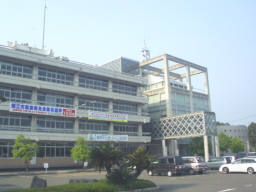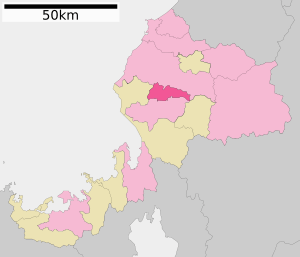Sabae, Fukui facts for kids
Quick facts for kids
Sabae
鯖江市
|
|||
|---|---|---|---|

Sabae City Hall
|
|||
|
|||

Location of Sabae in Fukui Prefecture
|
|||
| Country | Japan | ||
| Region | Chūbu (Hokuriku) | ||
| Prefecture | Fukui | ||
| Area | |||
| • Total | 84.59 km2 (32.66 sq mi) | ||
| Population
(June 2018)
|
|||
| • Total | 69,338 | ||
| • Density | 819.69/km2 (2,123.00/sq mi) | ||
| Time zone | UTC+9 (Japan Standard Time) | ||
| City symbols | |||
| -Tree | Sakura | ||
| -Flower | Azalea | ||
| -Bird | Aix galericulata | ||
| Phone number | 0778-51-2200 | ||
| Address | Nishiyamacho 13-1, Sabae-shi, Fukui-ken 916-8666 | ||
Sabae (鯖江市, Sabae-shi) is a city located in Fukui Prefecture, Japan. It's a cool place with a lot of history and interesting things to see! As of June 2018, about 69,338 people lived there in 24,167 homes. The city covers an area of about 84.59 square kilometers (32.66 square miles). This means there are about 820 people living in each square kilometer.
Contents
Geography of Sabae
Sabae is located in the middle part of Fukui Prefecture. It shares its borders with the city of Fukui to the north and the city of Echizen to the south.
Nearby Towns and Cities
Sabae is surrounded by several other places in Fukui Prefecture:
- Fukui
- Echizen
- Ikeda
- Echizen (town)
Sabae's Climate
Sabae has a humid climate. This means it has warm, wet summers and cold winters. It often gets a lot of snow in winter! The average temperature in Sabae is about 14.3 degrees Celsius (57.7 degrees Fahrenheit) each year. It rains a lot, with an average of 2417 millimeters (95 inches) of rain per year. September is usually the wettest month. The hottest month is August, with temperatures around 26.8 degrees Celsius (80.2 degrees Fahrenheit). January is the coldest, with temperatures around 3.0 degrees Celsius (37.4 degrees Fahrenheit).
Population Changes in Sabae
The number of people living in Sabae has been growing steadily over the last 50 years. This shows that more and more people are choosing to live in this city!
| Historical population | ||
|---|---|---|
| Year | Pop. | ±% |
| 1970 | 52,612 | — |
| 1980 | 59,579 | +13.2% |
| 1990 | 62,283 | +4.5% |
| 2000 | 64,898 | +4.2% |
| 2010 | 67,450 | +3.9% |
| 2020 | 68,302 | +1.3% |
History of Sabae
Sabae has a long history! It was once part of an old area called Echizen Province. During the Edo period (a time in Japanese history from 1603 to 1868), this area was part of a special land called Sabae Domain.
After the Meiji restoration in 1868 (when Japan changed a lot and the emperor got more power), Sabae became part of Imadate District in Fukui Prefecture. On April 1, 1889, Sabae officially became a town.
Over the years, Sabae grew by joining with nearby villages. In 1948, it merged with Shinyokoe and Funatsu. Then, on January 15, 1955, it joined with Shinmei, Katakami, Nakagawa, Tachimachi, Yoshikawa, and Yutaka to become the city of Sabae. In March 1957, the village of Kawada also became part of Sabae.
In 1995, Sabae was very proud to host the World Gymnastics Championships!
Sabae's Economy
Sabae is famous for its industries! It's one of the biggest places in Japan for making eyeglass frames. So, if you wear glasses, they might have been made in Sabae! The city also has important chemical factories and a rayon industry, which makes a type of fabric.
Education in Sabae
Sabae cares a lot about education! The city government runs 12 public elementary schools and three middle schools. The Fukui Prefectural Board of Education operates two public high schools. There's also a special college called the National Institute of Technology, Fukui College (NIT-Fukui), which is run by the national government.
Getting Around Sabae
Trains
Getting around Sabae by train is easy! The Hokuriku Main Line used to be run by JR West. But since March 16, 2024, a new company called Hapi-line Fukui now runs the trains in Sabae.
- Hapi-line Fukui
- Sabae, Kita-Sabae
 Fukui Railway Fukubu Line
Fukui Railway Fukubu Line
- Sundome Nishi - Nishi-Sabae - Nishiyama-Kōen - Mizuochi - Shinmei - Tobanaka
Highways
You can also travel to and from Sabae by car using these major roads:
Fun Places to Visit in Sabae
Sabae has many cool places to explore!
- Nishiyama Park (West Mountain Park) is a beautiful park, especially in spring. Hundreds of azalea flowers bloom on the hills, making it a colorful sight!
- Nishiyama Zoo is located right inside Nishiyama Park. You can see many animals there!
- The ruins of Mitsumine Castle are also in the city. You can imagine what it was like long ago!
- Ōzan Kofun Cluster and Kabutoyama Kofun are ancient burial mounds. They are very important historical sites.
- Sabae Megane Museum is a museum all about eyeglasses, showing how they are made and their history.
-
You can see a Red panda at Nishiyama Zoo.
See also
 In Spanish: Sabae para niños
In Spanish: Sabae para niños






